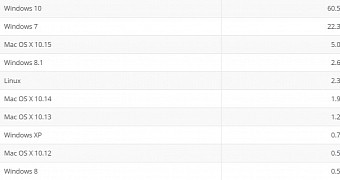Windows 10 is more than five years old, and while its adoption improved slowly at first, things have changed completely these days.
We’ve known for a while that Windows 10 was the number one desktop operating system, but the latest statistics show that its growth keeps improving every single month, and there’s little the other platforms can do to stop this impressive market performance.
Not even Linux, the platform that recorded an important growth in the first half of the year, can slow down the adoption of Windows 10.
More specifically, Windows as a whole is now powering 86.98 percent of the entire PC market, while Linux currently runs on 2.69 percent of the devices out there. For Windows, this is actually a small decline from 87.03 percent in July, but for Linux, the drop has been massive, its previous market share was 3.57 percent.
And yes, you’ve guessed it right. macOS is the big winner of the whole thing, as it improved from 8.95 percent to 9.55 percent in just one month.
But this doesn’t mean anything for Windows 10. Microsoft’s latest operating system increased its share from 59.37 percent in July to 60.57 percent in August, so this is the first month when Windows 10 breaks the 60 percent milestone. This is an important achievement for the 2015 OS version, as it means that more than 6 in 10 PCs out there are now running Windows 10.
As for the reasons Windows 10 is growing at such a fast pace, there’s no doubt that the demise of Windows 7 contributed to its accelerated adoption in 2020.
Microsoft stopped releasing security updates for Windows 7 in January this year, with the company insisting for everyone to move to Windows 10. And while at first the transition progressed slowly, the migration is now gaining traction, especially in the enterprise world, so this is just the beginning of another spike in Windows 10 adoption. What this means is that Windows 10 is likely to grow even more in the coming months as more computers are upgraded from Windows 7.
The 2009 OS version dropped in just one month from 23.35 percent to 22.31 percent, according to NetMarketShare, so it lost more than 1 percent market share in only 30 days. The decline is massive for Windows 7, but on the other hand, this translates to faster adoption for Windows 10, and Microsoft has every reason to be happy about how things are going here.
In the meantime, Microsoft is also working around the clock on providing users with new feature updates for Windows 10, and the company clearly takes its time to make sure everything is running just the way they are supposed to run.
The May 2020 Update, or version 2004, was officially announced in May this year, and the rollout started later the same month with a staged approach. This means that devices were getting the new feature update in waves, and while general availability was expected during the summer, we’re still not there.
However, I expect GA to be reached rather sooner than later, as Microsoft is supposed to finalize another Windows 10 feature update as soon as this month. Called Windows 10 version 20H2, this new feature update is scheduled to be completed in September, while the rollout to production devices should kick off in October or November.
Needless to say, the rollout will happen in stages as well, so once again the devices out there will be updated with Windows 10 version 20H2 gradually.

 14 DAY TRIAL //
14 DAY TRIAL //